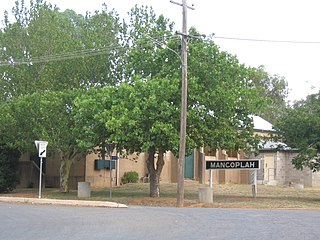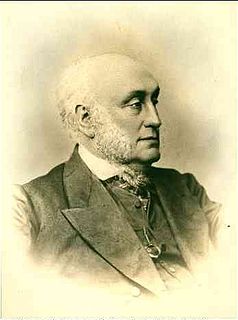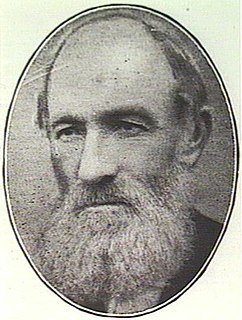Related Research Articles

The Advertiser is a daily tabloid format newspaper based in the city of Adelaide, South Australia. First published as a broadsheet named The South Australian Advertiser on 12 July 1858, it is currently a tabloid printed from Monday to Saturday. The Advertiser came under the ownership of Keith Murdoch in the 1950s, and the full ownership of Rupert Murdoch in 1987. It is a publication of Advertiser Newspapers Pty Ltd (ADV), a subsidiary of News Corp Australia, itself a subsidiary of News Corp. Through much of the 20th century, The Advertiser was Adelaide's morning broadsheet, The News the afternoon tabloid, with The Sunday Mail covering weekend sport, and Messenger Newspapers community news. The head office was relocated from a former premises in King William Street, to a new News Corp office complex, known as Keith Murdoch House at 31 Waymouth Street.

Boyle Travers Finniss was the first Premier of South Australia, serving from 24 October 1856 to 20 August 1857.

Mangoplah is a town approximately 36 kilometres (22 mi) south of Wagga Wagga in the Riverina region of New South Wales, Australia. At the 2016 census, Mangoplah had a population of 309. The name of the town is believed to mean "Kooris singing" in the Wiradjuri aboriginal language.

Benjamin Boothby was a South Australian colonial judge, who was removed from office for misbehaviour, one of four Australian supreme court judges removed in the 19th century.
Adelaide Educational Institution was a privately run non-sectarian academy for boys in Adelaide founded in 1852 by John Lorenzo Young.
He avoided rote learning, punishment and religious instruction, but taught moral philosophy, physiology, political economy and mechanical drawing ... (and) surveying on field trips.

William Patrick Auld, usually known as W.P. Auld, Pat or Patrick, was an Adelaide, South Australian vigneron and wine merchant born in Stalybridge.

The Prahran Telegraph was a weekly newspaper published from 1860 to 1930 in Prahran, an inner-suburb of the city of Melbourne, Australia. No copy pre-1866 is known to have survived. From 1866 until December 1888, the paper was called the Telegraph and St Kilda, Prahran and South Yarra Guardian. From January 1889 until 7 December 1902, the paper was known simply as the Prahran Telegraph. From 13 December 1902 the banner head read the Prahran Telegraph, with which is incorporated the St Kilda Advertiser and the Malvern Argus.
David Shannon served one term as a member of the South Australian House of Assembly for the Electoral district of Light from 9 September 1858 to 18 March 1860.

Ebenezer Ward was an Australian politician and journalist. He was a member of the South Australian House of Assembly from 1870 to 1880 and from 1881 to 1890, representing Gumeracha (1870–1880), Burra (1881–1884) and Frome (1884–1890). In 1890 he switched to the South Australian Legislative Council, where he represented Northern District until 1900. He was Minister for Agriculture and Education under James Boucaut from 1875 to 1876 and under John Colton from 1876 to 1877.
The Chronicle was a South Australian weekly newspaper, printed from 1858 to 1975, which evolved through a series of titles. It was printed by the publishers of The Advertiser, its content consisting largely of reprints of articles and Births, Marriages and Deaths columns from the parent newspaper. Its target demographic was country areas where mail delivery was infrequent, and businesses which serviced those areas.
Cawthorne and Co, also known as Cawthorne's Limited, was a company founded in 1870 in Adelaide, South Australia, by Charles Cawthorne and his father William Anderson Cawthorne, which dealt in musical instruments, sheet music and recordings, and acted as concert promoters.

William Dale was a carpenter, politician, and total abstinence activist in the young colony of South Australia.
The District Council of Glanville was a local government area in South Australia from 1864 to 1888.
The Australische Zeitung was a weekly German-language newspaper published in Tanunda, South Australia from 1860 until it ceased publication during World War I in 1916 due to anti-German sentiment. The newspaper also existed in a variety of earlier names or merged publications, reflecting the fluid nature of the newspaper industry in Victorian gold rush era colonial South Australia. The long history of German language Australian newspapers reflects the considerable German-speaking population which settled in South Australia in the nineteenth century.
Forlorn Hope was the name given by a group of seven men to an open boat in which they sailed and rowed from Adam Bay, Northern Territory to Champion Bay, Western Australia, a distance of some 2,000 miles (3,200 km) in May–August 1865.
Francis Edward Goldsmith MRCSL, often referred to as Edward Goldsmith, was a medical doctor in South Australia remembered for his time as the first surgeon and Protector of Aborigines of the pioneering settlement at Escape Cliffs, Northern Territory of Australia under B. T. Finniss. Within a year Finniss had demanded his resignation, citing insubordination.

Robert Henry Edmunds ISO was a surveyor, explorer and public servant in the early days of the colony of South Australia. He was involved in surveys and explorations in the Northern Territory with Finniss's party at Escape Cliffs and with the McKinlay exploration of the Alligator Rivers region.

Harrison Daniel Packard was a surveyor in the early days of the colony of South Australia. He served at Escape Cliffs under B. T. Finniss, and later under G. W. Goyder at Port Darwin.
A number of survey parties to the Northern Territory were involved in attempts to found a settlement in the Northern Territory during the years 1864–1870. This article describes attempts by the South Australian Government to found a settlement in the Northern Territory, and the people who took part in those ventures. It includes lists of all known participants.
References
- ↑ "The Express and Telegraph". Trove . Retrieved 19 September 2016– via National Library of Australia.
- ↑ "Topics of the Day". The South Australian Advertiser . Vol. V, no. 1271. 16 August 1862. p. 2. Retrieved 11 March 2017– via National Library of Australia.
- ↑ A. T. Saunders (19 July 1921). "A Newspaper's History". The Advertiser. South Australia. p. 10. Retrieved 31 May 2016– via National Library of Australia.
- ↑ "The Late Mr. Frederick Sinnett". The South Australian Advertiser . 28 November 1866. p. 2. Retrieved 11 March 2017– via National Library of Australia.
- ↑ "A Notable Statesman". The Advertiser . Adelaide: National Library of Australia. 9 October 1917. p. 4. Retrieved 10 November 2012.
- ↑ "Advertising". South Australian Weekly Chronicle . Vol. IX, no. 437. 15 December 1866. p. 1 (Supplement to the South Australian Weekly Chronicle). Retrieved 11 March 2017– via National Library of Australia.